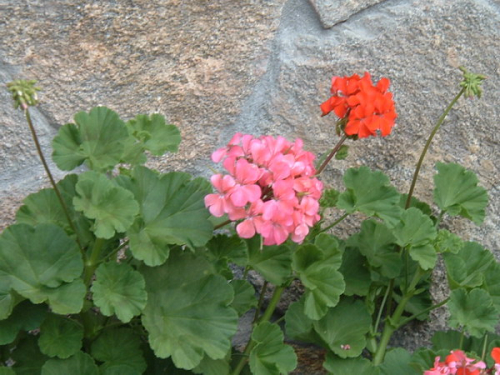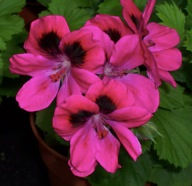
Geraniums are among the most popular outdoor plants, but they also make great indoor flowering plants. The plants we refer to as geraniums are really part of the genus Pelargonium which means “stork” in Latin. Native wildflowers and herbaceous perennials are the real members of the Geranium genus. There are over 200 Pelargonium species, most of them originally from South Africa. Geraniums come in a variety of colors (white, pink, salmon, red, fuchsia, lavender), leaf patterns (round, segmented, lacy), flower size (single or double bloom), and leaf color (green, green and white, or multicolored). They can be a compact upright plant or a graceful hanging vine. The vibrant flowers don’t have an appealing aroma, but there are several varieties that have leaves with lovely scents. Geraniums are a great addition to your indoor as well as outdoor plant collection but will bloom indoors only if you keep them in very bright light or direct sun at all times.
Types of Geraniums
Common Geranium (Pelargonium x hortorum)

These are compact plants that are often sold as bedding plants. Their leaves have distinct bands or zones in a darker color, tri-colored leaves, or silver or white areas that give them the nickname “zonal geraniums.” Common geraniums have single or double blooms that come in pink, white, red, and salmon.
Ivy- leaved geranium (Pelargonium peltatum)
This type of geranium has smooth leathery, ivy shaped leaves and grows as a cascading vine. It looks great in a hanging basket. The flowers have narrow petals, and the blooms are less showy and dense than those of the common geranium.

Martha Washington (Regal) Geranium (Pelargonium x domesticum)
These geraniums have woody stems, wrinkled leaves with pointed lobes, and the brightest flowers of all the geranium varieties. The blooms can range from a dramatic purple black to a bright yellow. Martha Washingtons are mainly grown in commercial greenhouses as potted plants. They are not very heat tolerant and do not do as well outdoors as the Common or Zonal geranium.
Scented–leaved Geranium
There are numerous varieties of scented geraniums all with different types of leaves and growing habits. The flowers are usually smaller and less showy than other types of geraniums. The leaves can be used to make sachets, tea, and potpourris. Some of the scents produced by geraniums are: Almond, Apple, Coconut, Lemon, Nutmeg, Old Spice, Peppermint, Rose, and Strawberry.
Geranium Care
Light
Indoors, geraniums can grow if placed in moderate light, but bloom only when placed in very bright intense light. Fluorescent lights about 10 to 12 inches from the plants can be used to supplement natural light. Outdoors, place your geraniums in very bright light or direct sunlight.
Water
Geraniums survive being under watered but quickly develop root rot when over watered. Wait until the top few inches of soil are dry, before watering, but never allow the roots to totally dry out.
Fertilizer
Fertilize every two weeks in the spring and summer with a water-soluble houseplant fertilizer high in potassium at ½ the recommended strength.
Temperature
Geraniums like it on the cool side, 65-70 during the day, and around 55 at night. Avoid cold, drafty areas as well as hot, dry places.
Humidity
The common Geraniums that are found in the stores are not fussy about humidity. However, very high humidity encourages bacterial and fungal growth; very low humidity encourages spider mites.
Flowering
Geraniums need very bright intense light to bloom. Immediately remove fading flowers to encourage additional blooms.
Pests
Aphids, whitefly, and spider mites can be a problem. If you place your geranium outside for the summer, be careful caterpillars don’t munch on it.
Diseases
Bacterial leaf spot, gray mold, blossom blight, or rust can develop if the humidity is too high, or the leaves are kept wet.
Soil
The right soil is important if you want to successfully grow geraniums. Use a quick draining all-purpose loose houseplant potting mixture that contains a fair amount of nutrients. If you plant Geraniums outside, soil in the garden that is heavy and clay-like needs to be lightened with sand and compost.
Pot Size
As with all houseplants, there must be drainage holes in the pots and geraniums should never be allowed to sit in water. They like to be a little root-bound so don’t be in a rush to re-pot your plants; when you do move them to a larger pot, use a container only one size larger than your existing pot.
Propagation
Geraniums root easily from stem cuttings in spring and early summer.
Toxicity
Geraniums are non-poisonous.
Frequently Asked Questions
The centers of the flowers on my geranium always dry-out. Does it need more humidity?
It sounds like a fungus infection, probably botrtis. The infection is caused by water getting on the flowers, poor air circulation, or just overwatering the plant in general. Avoid over head watering systems, keeping your pots of geraniums too close together, and be careful not to get any water on the flowers.
My geranium is falling apart, spots on the leaves, leaves falling off, and stems rotting. It was such a gorgeous plant. What happened??
Sounds like a bad case of Bacterial Leaf Spot/Blight (Xanthomonas campestris pv. pelargonii). Warm humid atmosphere and poor air circulation are usually the cause. Remove all the leaves that have spots and keep the plant leaves and stems dry at all times. If the problem persists, try a copper fungicide.
Is there a geranium that keeps mosquitoes away?
There is a new plant called a Mosquito Geranium. It has had genes introduced into it which code for citronella. The citronella smell, which repels mosquitoes, is released when the leaves are rubbed or crushed. Research is still being conducted to prove whether this plant really acts as a mosquito repellant.
My geranium never blooms! Can you tell me what to do? Should I get a different plant food?
The main reason geraniums don’t bloom is there is not enough bright light. Move your geraniums to very bright indirect light or even direct sunlight. When the plant does bloom, quickly remove the flowers once they start to fade to encourage the plant to produce more blooms. You can also try using a fertilizer rich in phosphorous.
Judy Feldstein is the founder of Foliage Unlimited, one of the largest interior plant design, sales, & maintenance companies in Arizona. Judy’s website HousePlant411.com helps plant enthusiasts identify, select, and care for houseplants.
Related Articles & Free Email Newsletter
A Miniature Rose Prospers Outdoors




Comment here